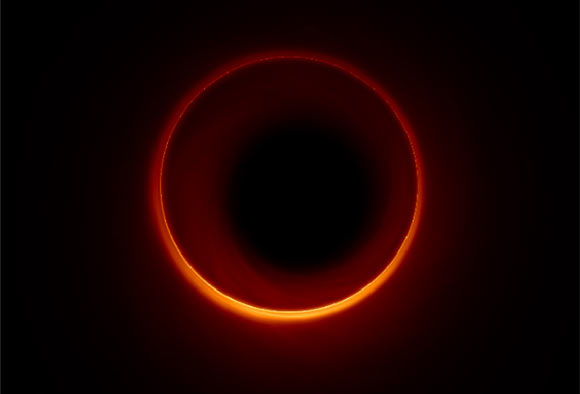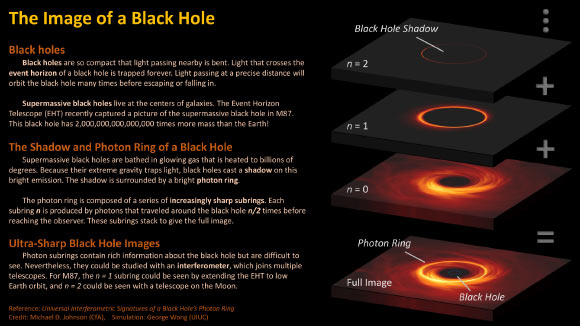Astronomers Discover Way to Get Sharp Images of Black Hole’s Photon Rings | Astronomy – Sci-News.com
In April 2019, the Event Horizon Telescope (EHT) Collaboration released stunning images of the supermassive black hole in Messier 87, a giant elliptical galaxy located some 53 million light-years from us in the constellation Virgo. Now, a team of researchers has published new calculations that predict that embedded within an image of a black hole lies a thin ‘photon ring,’ which is composed of an infinite sequence of self-similar subrings.

Time-averaged image of a general relativistic magnetohydrodynamic simulation of the supermassive black hole in Messier 87. Image credit: Johnson et al, doi: 10.1126/sciadv.aaz1310.
Black holes trap photons that cross their event horizon and cast a shadow on their bright surrounding emission from hot infalling gas.
A photon ring encircles this shadow, produced from light that is concentrated by the strong gravity near the black hole.
This photon ring carries the fingerprint of the black hole — its size and shape encode the mass and rotation or spin of the black hole.
With the image of Messier 87’s supermassive black hole, astronomers have a new tool to study these extraordinary objects.
“The image of a black hole actually contains a nested series of rings,” said lead author Dr. Michael Johnson, an astronomer with the Center for Astrophysics at Harvard and Smithsonian.
“Each successive ring has about the same diameter but becomes increasingly sharper because its light orbited the black hole more times before reaching the observer.”
“With the current EHT image, we’ve caught just a glimpse of the full complexity that should emerge in the image of any black hole.”
“This is an extremely exciting time to be thinking about the physics of black holes,” said co-author Dr. Daniel Kapec, a researcher in the Institute for Advanced Study.
“Einstein’s theory of general relativity makes a number of striking predictions for the types of observations that are finally coming within reach, and I think we can look forward to lots of advances in the coming years.”
“As a theorist, I find the rapid convergence between theory and experiment especially rewarding, and I hope we can continue to isolate and observe more universal predictions of general relativity as these experiments become more sensitive.”

The image of a black hole has a bright ring of emission surrounding a ‘shadow’ cast by the black hole. This ring is composed of a stack of increasingly sharp subrings that correspond to the number of orbits that photons took around the black hole before reaching the observer. Image credit: George Wong & Michael Johnson, CfA.
“Bringing together experts from different fields enabled us to really connect a theoretical understanding of the photon ring to what is possible with observation,” said co-author George Wong, a physics graduate student at the University of Illinois at Urbana-Champaign.
Wong developed software to produce simulated black hole images at higher resolutions than had previously been computed and to decompose these into the predicted series of sub-images.
“What really surprised us was that while the nested subrings are almost imperceptible to the naked eye on images — even perfect images — they are strong and clear signals for arrays of telescopes called interferometers,” Dr. Johnson said.
“While capturing black hole images normally requires many distributed telescopes, the subrings are perfect to study using only two telescopes that are very far apart. Adding one space telescope to the EHT would be enough.”
“Black hole physics has always been a beautiful subject with deep theoretical implications, but now it has also become an experimental science. As a theorist, I am delighted to finally glean real data about these objects that we’ve been abstractly thinking about for so long,” said co-author Dr. Alex Lupsasca, a scientist from the Harvard Society of Fellows.
The team’s paper was published in the journal Science Advances.
_____
Michael D. Johnson et al. 2020. Universal interferometric signatures of a black hole’s photon ring. Science Advances 6 (12): eaaz1310; doi: 10.1126/sciadv.aaz1310






